Twitter Bot Detection
Twitter-bot detection is the process of identifying and categorizing automated accounts on Twitter.
Papers and Code
On the efficacy of old features for the detection of new bots
Jun 24, 2025
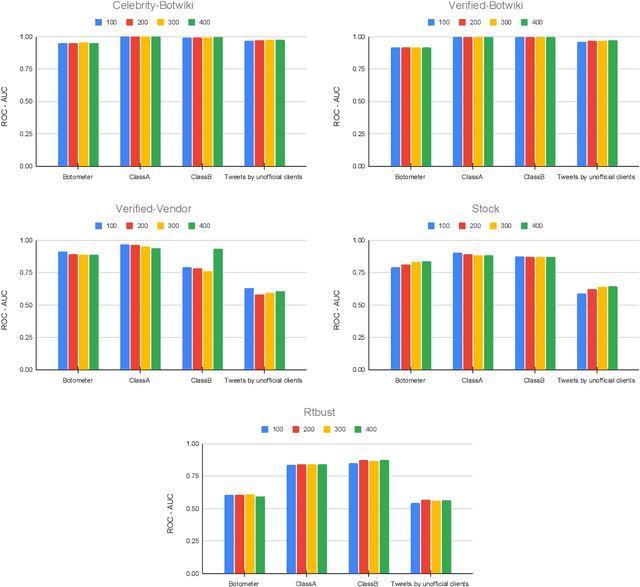

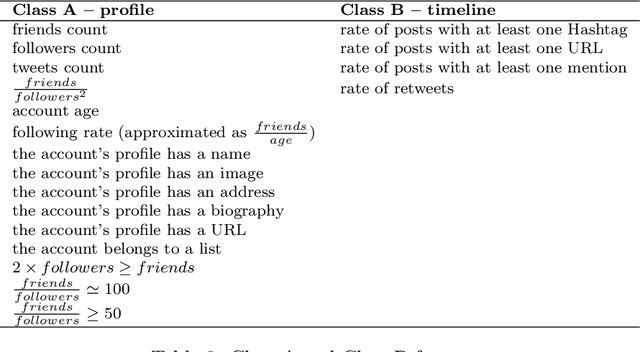
For more than a decade now, academicians and online platform administrators have been studying solutions to the problem of bot detection. Bots are computer algorithms whose use is far from being benign: malicious bots are purposely created to distribute spam, sponsor public characters and, ultimately, induce a bias within the public opinion. To fight the bot invasion on our online ecosystem, several approaches have been implemented, mostly based on (supervised and unsupervised) classifiers, which adopt the most varied account features, from the simplest to the most expensive ones to be extracted from the raw data obtainable through the Twitter public APIs. In this exploratory study, using Twitter as a benchmark, we compare the performances of four state-of-art feature sets in detecting novel bots: one of the output scores of the popular bot detector Botometer, which considers more than 1,000 features of an account to take a decision; two feature sets based on the account profile and timeline; and the information about the Twitter client from which the user tweets. The results of our analysis, conducted on six recently released datasets of Twitter accounts, hint at the possible use of general-purpose classifiers and cheap-to-compute account features for the detection of evolved bots.
* pre-print version
BotUmc: An Uncertainty-Aware Twitter Bot Detection with Multi-view Causal Inference
Mar 04, 2025Social bots have become widely known by users of social platforms. To prevent social bots from spreading harmful speech, many novel bot detections are proposed. However, with the evolution of social bots, detection methods struggle to give high-confidence answers for samples. This motivates us to quantify the uncertainty of the outputs, informing the confidence of the results. Therefore, we propose an uncertainty-aware bot detection method to inform the confidence and use the uncertainty score to pick a high-confidence decision from multiple views of a social network under different environments. Specifically, our proposed BotUmc uses LLM to extract information from tweets. Then, we construct a graph based on the extracted information, the original user information, and the user relationship and generate multiple views of the graph by causal interference. Lastly, an uncertainty loss is used to force the model to quantify the uncertainty of results and select the result with low uncertainty in one view as the final decision. Extensive experiments show the superiority of our method.
Collaborative Content Moderation in the Fediverse
Jan 10, 2025



The Fediverse, a group of interconnected servers providing a variety of interoperable services (e.g. micro-blogging in Mastodon) has gained rapid popularity. This sudden growth, partly driven by Elon Musk's acquisition of Twitter, has created challenges for administrators though. This paper focuses on one particular challenge: content moderation, e.g. the need to remove spam or hate speech. While centralized platforms like Facebook and Twitter rely on automated tools for moderation, their dependence on massive labeled datasets and specialized infrastructure renders them impractical for decentralized, low-resource settings like the Fediverse. In this work, we design and evaluate FedMod, a collaborative content moderation system based on federated learning. Our system enables servers to exchange parameters of partially trained local content moderation models with similar servers, creating a federated model shared among collaborating servers. FedMod demonstrates robust performance on three different content moderation tasks: harmful content detection, bot content detection, and content warning assignment, achieving average per-server macro-F1 scores of 0.71, 0.73, and 0.58, respectively.
Entendre, a Social Bot Detection Tool for Niche, Fringe, and Extreme Social Media
Aug 13, 2024Social bots-automated accounts that generate and spread content on social media-are exploiting vulnerabilities in these platforms to manipulate public perception and disseminate disinformation. This has prompted the development of public bot detection services; however, most of these services focus primarily on Twitter, leaving niche platforms vulnerable. Fringe social media platforms such as Parler, Gab, and Gettr often have minimal moderation, which facilitates the spread of hate speech and misinformation. To address this gap, we introduce Entendre, an open-access, scalable, and platform-agnostic bot detection framework. Entendre can process a labeled dataset from any social platform to produce a tailored bot detection model using a random forest classification approach, ensuring robust social bot detection. We exploit the idea that most social platforms share a generic template, where users can post content, approve content, and provide a bio (common data features). By emphasizing general data features over platform-specific ones, Entendre offers rapid extensibility at the expense of some accuracy. To demonstrate Entendre's effectiveness, we used it to explore the presence of bots among accounts posting racist content on the now-defunct right-wing platform Parler. We examined 233,000 posts from 38,379 unique users and found that 1,916 unique users (4.99%) exhibited bot-like behavior. Visualization techniques further revealed that these bots significantly impacted the network, amplifying influential rhetoric and hashtags (e.g., #qanon, #trump, #antilgbt). These preliminary findings underscore the need for tools like Entendre to monitor and assess bot activity across diverse platforms.
Using RL to Identify Divisive Perspectives Improves LLMs Abilities to Identify Communities on Social Media
Jun 03, 2024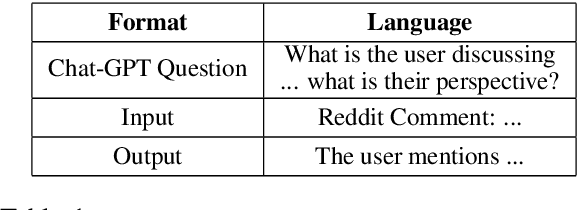
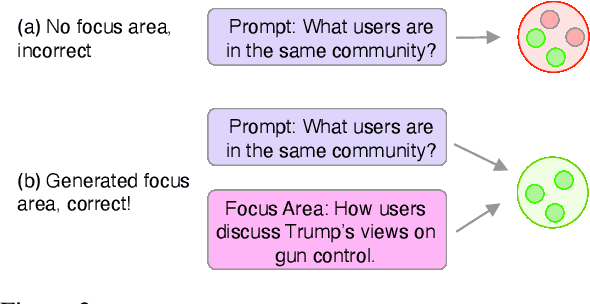
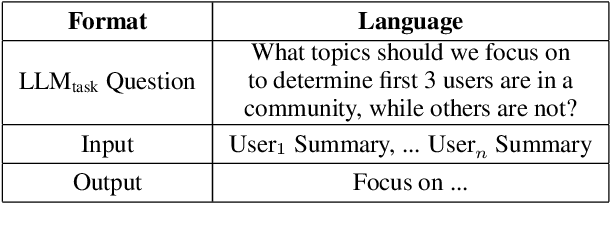
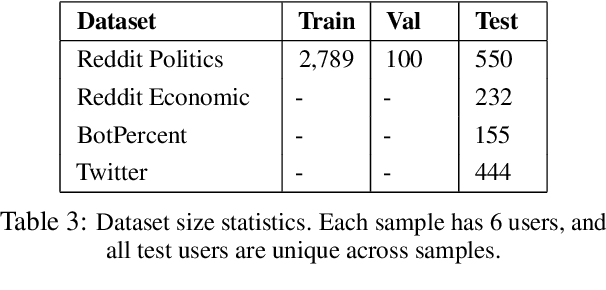
The large scale usage of social media, combined with its significant impact, has made it increasingly important to understand it. In particular, identifying user communities, can be helpful for many downstream tasks. However, particularly when models are trained on past data and tested on future, doing this is difficult. In this paper, we hypothesize to take advantage of Large Language Models (LLMs), to better identify user communities. Due to the fact that many LLMs, such as ChatGPT, are fixed and must be treated as black-boxes, we propose an approach to better prompt them, by training a smaller LLM to do this. We devise strategies to train this smaller model, showing how it can improve the larger LLMs ability to detect communities. Experimental results show improvements on Reddit and Twitter data, on the tasks of community detection, bot detection, and news media profiling.
Descriptive Kernel Convolution Network with Improved Random Walk Kernel
Feb 08, 2024



Graph kernels used to be the dominant approach to feature engineering for structured data, which are superseded by modern GNNs as the former lacks learnability. Recently, a suite of Kernel Convolution Networks (KCNs) successfully revitalized graph kernels by introducing learnability, which convolves input with learnable hidden graphs using a certain graph kernel. The random walk kernel (RWK) has been used as the default kernel in many KCNs, gaining increasing attention. In this paper, we first revisit the RWK and its current usage in KCNs, revealing several shortcomings of the existing designs, and propose an improved graph kernel RWK+, by introducing color-matching random walks and deriving its efficient computation. We then propose RWK+CN, a KCN that uses RWK+ as the core kernel to learn descriptive graph features with an unsupervised objective, which can not be achieved by GNNs. Further, by unrolling RWK+, we discover its connection with a regular GCN layer, and propose a novel GNN layer RWK+Conv. In the first part of experiments, we demonstrate the descriptive learning ability of RWK+CN with the improved random walk kernel RWK+ on unsupervised pattern mining tasks; in the second part, we show the effectiveness of RWK+ for a variety of KCN architectures and supervised graph learning tasks, and demonstrate the expressiveness of RWK+Conv layer, especially on the graph-level tasks. RWK+ and RWK+Conv adapt to various real-world applications, including web applications such as bot detection in a web-scale Twitter social network, and community classification in Reddit social interaction networks.
LMBot: Distilling Graph Knowledge into Language Model for Graph-less Deployment in Twitter Bot Detection
Jul 03, 2023As malicious actors employ increasingly advanced and widespread bots to disseminate misinformation and manipulate public opinion, the detection of Twitter bots has become a crucial task. Though graph-based Twitter bot detection methods achieve state-of-the-art performance, we find that their inference depends on the neighbor users multi-hop away from the targets, and fetching neighbors is time-consuming and may introduce bias. At the same time, we find that after finetuning on Twitter bot detection, pretrained language models achieve competitive performance and do not require a graph structure during deployment. Inspired by this finding, we propose a novel bot detection framework LMBot that distills the knowledge of graph neural networks (GNNs) into language models (LMs) for graph-less deployment in Twitter bot detection to combat the challenge of data dependency. Moreover, LMBot is compatible with graph-based and graph-less datasets. Specifically, we first represent each user as a textual sequence and feed them into the LM for domain adaptation. For graph-based datasets, the output of LMs provides input features for the GNN, enabling it to optimize for bot detection and distill knowledge back to the LM in an iterative, mutually enhancing process. Armed with the LM, we can perform graph-less inference, which resolves the graph data dependency and sampling bias issues. For datasets without graph structure, we simply replace the GNN with an MLP, which has also shown strong performance. Our experiments demonstrate that LMBot achieves state-of-the-art performance on four Twitter bot detection benchmarks. Extensive studies also show that LMBot is more robust, versatile, and efficient compared to graph-based Twitter bot detection methods.
BotArtist: Twitter bot detection Machine Learning model based on Twitter suspension
Jun 02, 2023Twitter as one of the most popular social networks, offers a means for communication and online discourse, which unfortunately has been the target of bots and fake accounts, leading to the manipulation and spreading of false information. Towards this end, we gather a challenging, multilingual dataset of social discourse on Twitter, originating from 9M users regarding the recent Russo-Ukrainian war, in order to detect the bot accounts and the conversation involving them. We collect the ground truth for our dataset through the Twitter API suspended accounts collection, containing approximately 343K of bot accounts and 8M of normal users. Additionally, we use a dataset provided by Botometer-V3 with 1,777 Varol, 483 German accounts, and 1,321 US accounts. Besides the publicly available datasets, we also manage to collect 2 independent datasets around popular discussion topics of the 2022 energy crisis and the 2022 conspiracy discussions. Both of the datasets were labeled according to the Twitter suspension mechanism. We build a novel ML model for bot detection using the state-of-the-art XGBoost model. We combine the model with a high volume of labeled tweets according to the Twitter suspension mechanism ground truth. This requires a limited set of profile features allowing labeling of the dataset in different time periods from the collection, as it is independent of the Twitter API. In comparison with Botometer our methodology achieves an average 11% higher ROC-AUC score over two real-case scenario datasets.
SeGA: Preference-Aware Self-Contrastive Learning with Prompts for Anomalous User Detection on Twitter
Dec 17, 2023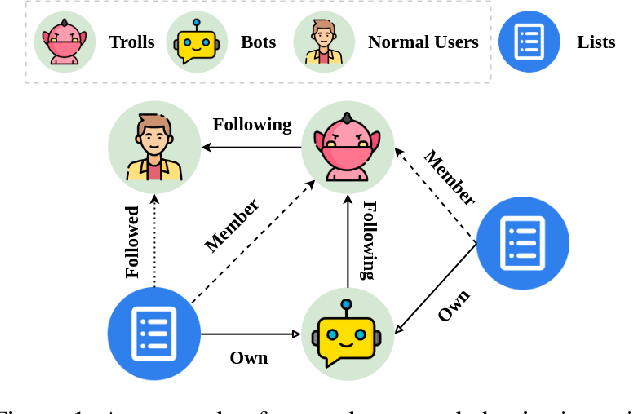
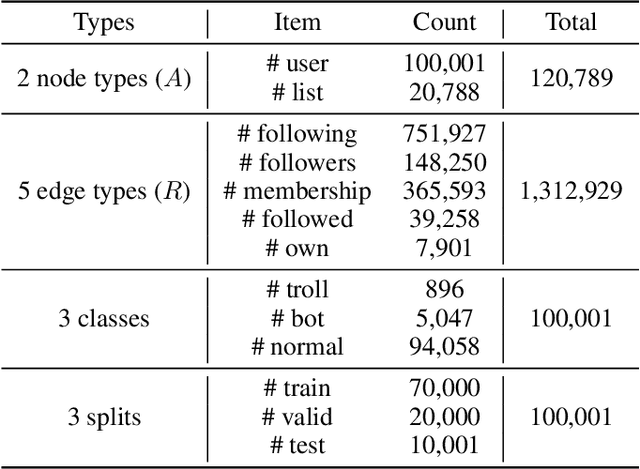
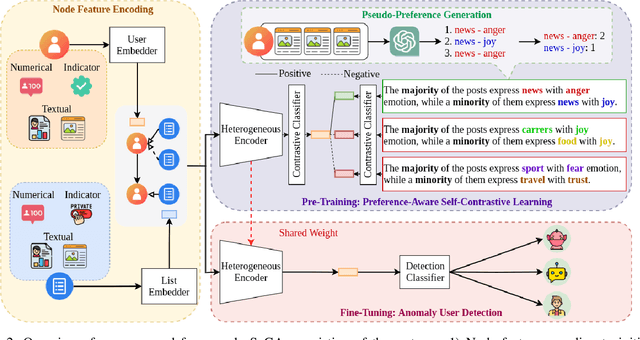

In the dynamic and rapidly evolving world of social media, detecting anomalous users has become a crucial task to address malicious activities such as misinformation and cyberbullying. As the increasing number of anomalous users improves the ability to mimic normal users and evade detection, existing methods only focusing on bot detection are ineffective in terms of capturing subtle distinctions between users. To address these challenges, we proposed SeGA, preference-aware self-contrastive learning for anomalous user detection, which leverages heterogeneous entities and their relations in the Twittersphere to detect anomalous users with different malicious strategies. SeGA utilizes the knowledge of large language models to summarize user preferences via posts. In addition, integrating user preferences with prompts as pseudo-labels for preference-aware self-contrastive learning enables the model to learn multifaceted aspects for describing the behaviors of users. Extensive experiments on the proposed TwBNT benchmark demonstrate that SeGA significantly outperforms the state-of-the-art methods (+3.5\% ~ 27.6\%) and empirically validate the effectiveness of the model design and pre-training strategies. Our code and data are publicly available at https://github.com/ying0409/SeGA.
Multimodal Detection of Social Spambots in Twitter using Transformers
Aug 28, 2023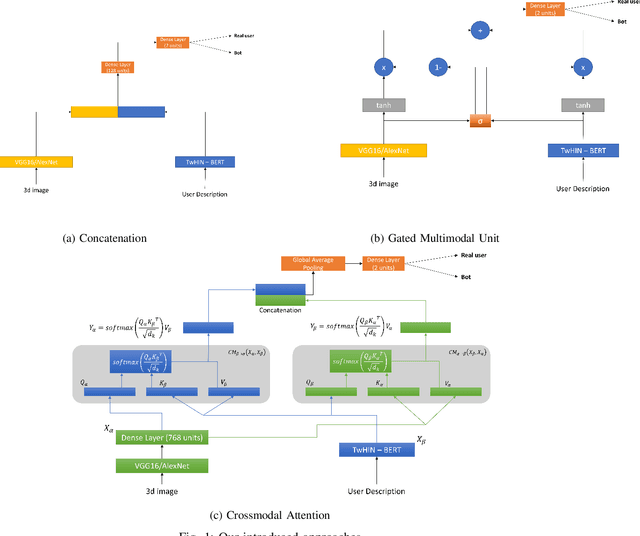
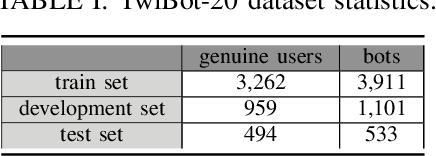
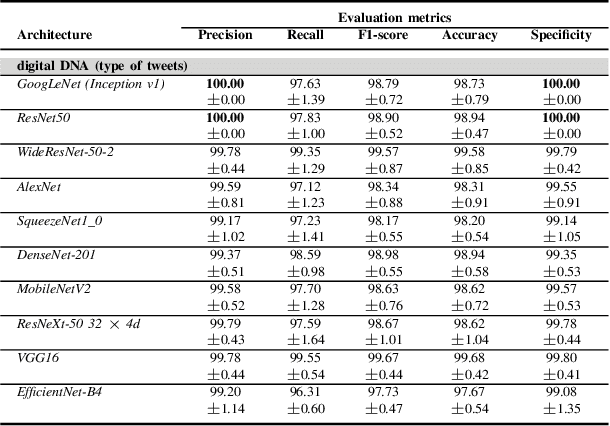
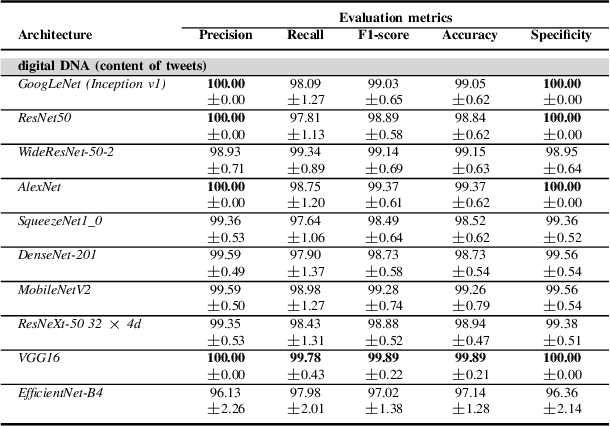
Although not all bots are malicious, the vast majority of them are responsible for spreading misinformation and manipulating the public opinion about several issues, i.e., elections and many more. Therefore, the early detection of social spambots is crucial. Although there have been proposed methods for detecting bots in social media, there are still substantial limitations. For instance, existing research initiatives still extract a large number of features and train traditional machine learning algorithms or use GloVe embeddings and train LSTMs. However, feature extraction is a tedious procedure demanding domain expertise. Also, language models based on transformers have been proved to be better than LSTMs. Other approaches create large graphs and train graph neural networks requiring in this way many hours for training and access to computational resources. To tackle these limitations, this is the first study employing only the user description field and images of three channels denoting the type and content of tweets posted by the users. Firstly, we create digital DNA sequences, transform them to 3d images, and apply pretrained models of the vision domain, including EfficientNet, AlexNet, VGG16, etc. Next, we propose a multimodal approach, where we use TwHIN-BERT for getting the textual representation of the user description field and employ VGG16 for acquiring the visual representation for the image modality. We propose three different fusion methods, namely concatenation, gated multimodal unit, and crossmodal attention, for fusing the different modalities and compare their performances. Extensive experiments conducted on the Cresci '17 dataset demonstrate valuable advantages of our introduced approaches over state-of-the-art ones reaching Accuracy up to 99.98%.
 Add to Chrome
Add to Chrome Add to Firefox
Add to Firefox Add to Edge
Add to Edge